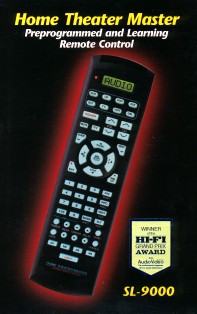|
...Continued from Page 1.
 The default device button labels are Audio, CD, DVD, Auxiliary, SAT, TV, VCR and Cable, though the LCD can be changed to one of 24 preset labels such as VCR2, WebTV, Light and DSS. For my setup I changed Aux to Tape1, Sat to Tape2 and Cable to VCR2 but left the rest at their defaults. Like most good remote controls, the device buttons can be programmed to send a power or input signal when they’re pressed. The SL-9000 goes one step further in only sending that command the second time you press the button. Doing this also changes the device label, for example, to A_VCR which signifies "Automatic Audio Mode". What this means is that specific buttons on the remote are changed to reflect whatever is programmed on the Audio device. These buttons include volume, mute and 14 others along the bottom and lower right side. While this can be handy when you want to adjust center and rear volume levels while still having access to the device’s transport or tuner controls, it also means that if you have other programmed signals on these buttons you’ll have to push the device button a third time to return to regular use.
The default device button labels are Audio, CD, DVD, Auxiliary, SAT, TV, VCR and Cable, though the LCD can be changed to one of 24 preset labels such as VCR2, WebTV, Light and DSS. For my setup I changed Aux to Tape1, Sat to Tape2 and Cable to VCR2 but left the rest at their defaults. Like most good remote controls, the device buttons can be programmed to send a power or input signal when they’re pressed. The SL-9000 goes one step further in only sending that command the second time you press the button. Doing this also changes the device label, for example, to A_VCR which signifies "Automatic Audio Mode". What this means is that specific buttons on the remote are changed to reflect whatever is programmed on the Audio device. These buttons include volume, mute and 14 others along the bottom and lower right side. While this can be handy when you want to adjust center and rear volume levels while still having access to the device’s transport or tuner controls, it also means that if you have other programmed signals on these buttons you’ll have to push the device button a third time to return to regular use.
Punching Through
As if this "audio pass through" functionality wasn’t enough, the SL-9000 also provides for what it calls "Punch Throughs". This allows you to configure the remote to transparently use one device’s buttons (volume, channel or transport controls) on any number of other devices. You could have the Volume commands for the TV punch through to the VCR and Satellite. Or, you could have the VCR’s transport controls punch through to the TV, Satellite and Cable box. Unlike Audio Mode, however, this is a permanent setup and can’t be changed on the fly.
The SL-9000 conveniently provides for 10 macros containing up to 15 commands each. In total, you can use 4 macro buttons along the bottom plus the power button for the top row of devices (Audio, CD, DVD and Auxiliary) and the bottom row (Satellite, TV, VCR and Cable) – devices can’t have their own unique macros nor are remote-wide macros possible. While programming a macro you can select from buttons in all 8 devices, although it’s important to remember that each press of a device button counts as one command and inserts a half second delay. The manual warns that it can take up to 15 seconds to send out all 15 commands, and in testing this estimate wasn’t far off.
Fit & Finish
The physical case is finished in a light matte texture that provides great grip. Even though it’s designed with angles rather than curves it still manages to be both comfortable to hold and not too heavy – partly due to the fact that it requires 4 AAA batteries rather than the larger and heavier AA batteries. Buttons on both sides can be comfortably reached whether you’re left or right handed. Center weighting is proper for the placement of important buttons, about one third of the way down from the top, and overall it seems quite sturdy. The buttons have enough tactile resistance that they won’t accidentally be activated by resting fingers, but aren’t so firm that you’ll have to consciously press hard to get a signal out. Speaking of signals, the SL-9000’s small IR cover really belays the powerful spread of the transmitter beneath. It worked beautifully behind objects and at angles from which one wouldn’t reasonably expect it to function. A small LED next to the screen lights up when a signal is transmitting.
| 
